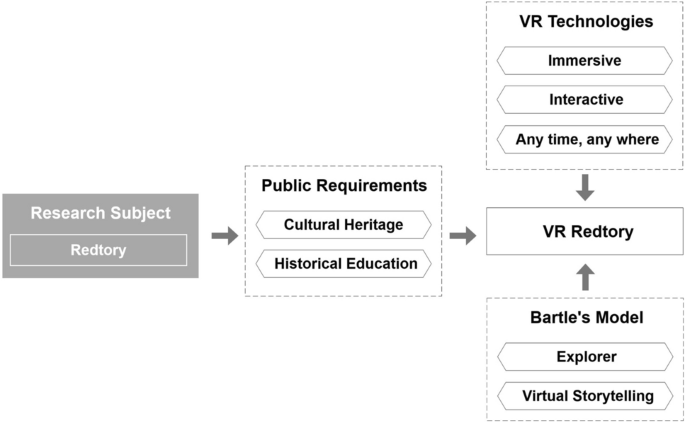Integrating restoration and interactive exploration to enhance cultural heritage through VR storytelling

Wang, M., Jiang, G. B. & Zhu, H. Discussion on spatial perception of industrial heritage tourism destination based on visual research method: The case of guangzhou redtory. Tour. Tribune 32, 28–38 (2017).
Yangcheng Evening News, G. Farewell, Redtory, which has been with Guangzhou citizens for 10 years, is officially closed. Yangcheng Evening News https://baijiahao.baidu.com/s?id=1650917381117974880&wfr=spider &for=pc (2022).
Guangzhou Daily, G. The new campus of Tianhe children’s palace is here! settled in the plot on the south side of Redtory. Guangzhou Daily https://baijiahao.baidu.com/s?id=1742064056145627292&wfr=spider &for=pc (2022).
Bruno, A. & Guitton, P. Virtual Reality and Augmented reality: Myths and Realities (John Wiley and Sons, Hoboken, 2018).
Anthes, C., García-Hernández, R. J., Wiedemann, M. & Kranzlmüller, D. State of the art of virtual reality technology. In 2016 IEEE Aerospace Conference 1–19. https://doi.org/10.1109/AERO.2016.7500674 (2016).
Slater, M. & Sanchez-Vives, M. V. Enhancing our lives with immersive virtual reality. Front. Robot. AI 3, 74. https://doi.org/10.3389/frobt.2016.00074 (2016).
Riva, G. & Wiederhold, B. K. How cyberpsychology and virtual reality can help us to overcome the psychological burden of coronavirus. Cyberpsychol. Behav. Soc. Netw. 23, 277–279 (2020).
Roussou, M. & Katifori, A. Flow, staging, wayfinding, personalization: Evaluating user experience with mobile museum narratives. Multimodal Technol. Interact. 2, 32. https://doi.org/10.3390/mti2020032 (2018).
Bekele, M. K., Pierdicca, R., Frontoni, E., Malinverni, E. S. & Gain, J. A survey of augmented, virtual, and mixed reality for cultural heritage. J. Comput. Cult. Herit. 11, 1–36. https://doi.org/10.1145/3145534 (2018).
Radianti, J., Majchrzak, T. A., Fromm, J. & Wohlgenannt, I. A systematic review of immersive virtual reality applications for higher education: Design elements, lessons learned, and research agenda. Comput. Educ. 147, 103778. https://doi.org/10.1016/j.compedu.2019.103778 (2020).
Lasse, J. & Flemming, K. A review of the use of virtual reality head-mounted displays in education and training. Educ. Inf. Technol. 23, 1515–1529. https://doi.org/10.1007/s10639-017-9676-0 (2018).
Zweifach, S. & Triola, M. Extended reality in medical education: Driving adoption through provider-centered design. Digital Biomarkers 3, 14–21. https://doi.org/10.1159/000498923 (2019).
Milovanovic, J., Moreau, G., Siret, D. & Miguet, F. Virtual and augmented reality in architectural design and education. In 17th International Conference, CAAD Futures 2017 (Istanbul, Turkey, 2017).
Parmaxi, A. Virtual reality in language learning: A systematic review and implications for research and practice. Interact. Learn. Environ. 31, 172–184. https://doi.org/10.1080/10494820.2020.1765392 (2023).
Salman, N. et al. Towards a model of user experience in immersive virtual environments. In Advances in Human-Computer Interaction, Vol. 2018 7827286. https://doi.org/10.1155/2018/7827286 (2018).
Hu, X., Ng, J. & Lee, J. H. VR creation experience in cultural heritage education: A preliminary exploration. Proc. Assoc. Inf. Sci. Technol. 56, 422–426 (2019).
Mariapina, T., Maria, D. L., Salvatore, C. & Adele, M. Innovating the cultural heritage museum service model through virtual reality and augmented reality: the effects on the overall visitor experience and satisfaction. J. Herit. Tour. 17, 1–19 (2022).
Lin, L.-P.L., Huang, S.-C.L. & Ho, Y.-C. Could virtual reality effectively market slow travel in a heritage destination?. Tour. Manag. 78, 104027 (2020).
Marto, A., Melo, M., Gonçalves, A. & Bessa, M. Multisensory augmented reality in cultural heritage: Impact of different stimuli on presence, enjoyment, knowledge and value of the experience. IEEE Access 8, 193744–193756 (2020).
Xing, Y., Xie, P., Zheng, J., Luo, Y. & Xiao, Y. Enhancing cultural education through integrating restoration and vr storytelling exploration. In 2023 IEEE International Symposium on Mixed and Augmented Reality Adjunct (ISMAR-Adjunct) 77–80. https://doi.org/10.1109/ISMAR-Adjunct60411.2023.00024 (2023).
Häkkilä, J. et al. Visiting a virtual graveyard: Designing virtual reality cultural heritage experiences. In Proceedings of the 18th International Conference on Mobile and Ubiquitous Multimedia, MUM ’19 (Association for Computing Machinery, 2019).
Rizvic, S., Boskovic, D., Okanovic, V., Sljivo, S. & Zukic, M. Interactive digital storytelling: Bringing cultural heritage in a classroom. J. Comput. Educ. 6, 143–166 (2019).
Bruno, F. et al. Digital technologies for the sustainable development of the accessible underwater cultural heritage sites. J. Mar. Sci. Eng. 8, 955 (2020).
Richard, B. Hearts, clubs, diamonds, spades: Players who suit muds. J. MUD Res. 1, 1–19 (1996).
Prasetyo, A., Nur, D. & Iwan, J. Students’s mathematical connection ability and disposition reviewed by Keirsey personality type through eliciting activities mathematics learning model. Unnes J. Math. Educ. 6, 190–197 (2017).
Busch, M. et al. Player type models: Towards empirical validation. In Proceedings of the 2016 CHI Conference Extended Abstracts on Human Factors in Computing Systems, CHI EA ’16 1835–1841 (Association for Computing Machinery, 2016).
Saverio, I., Mario, V. & Gianni, V. Gamification in corporate training to enhance engagement: An approach. Int. J. Emerg. Technol. Learn. (iJET) 15, 69–84 (2020).
Zeynep, C. & Yavuz, S. A comprehensive player types model: Player head. Interact. Learn. Environ. 31, 2930–2946 (2023).
Evangelos, C., Jason, D., Nicholas, K. & George, L. Gamification Mechanisms in Cyber Range and Cyber Security Training Environments: A Review (IGI Global, Hershey, 2022).
UNESCO. Project: Virtual museum of stolen cultural objects details. Yangcheng Evening News https://core.unesco.org/en/project/505GLO4000 (2024).
Jin, S., Fan, M. & Kadir, A. Immersive spring morning in the Han palace: Learning traditional Chinese art via virtual reality and multi-touch tabletop. Int. J. Hum. Comput. Interact. 38, 213–226. https://doi.org/10.1080/10447318.2021.1930389 (2022).
Akrivi, K. et al. The EMOTIVE project-emotive virtual cultural experiences through personalized storytelling. In Cira@ euromed, Vol. 2235 11–20 (2018).
Nop, K., Manissaward, J. & Oattarapon, T. Development of character design frameworks using game engine: unreal engine. In 2019 Joint International Conference on Digital Arts, Media and Technology with ECTI Northern Section Conference on Electrical, Electronics, Computer and Telecommunications Engineering (ECTI DAMT-NCON) 54–59 (2019).
Büschel, W., Lehmann, A. & Dachselt, R. MIRIA: a mixed reality toolkit for the in-situ visualization and analysis of spatio-temporal interaction data. In Proceedings of the 2021 CHI Conference on Human Factors in Computing Systems, CHI ’21 (Association for Computing Machinery, 2021).
Ong, S. & Siddaraju, V. K. Introduction to the Mixed Reality Toolkit 85–110 (Apress, Berkeley, 2021).
Pokorný, P. & Falešník, D. Historical 3D visualisations of starý světlov castle using blender and unreal engine. In Software Engineering and Algorithms (ed. Silhavy, R.) 351–362 (Springer International Publishing, Cham, 2021).
Lovreglio, R., Duan, X., Rahouti, A., Phipps, R. & Nilsson, D. Comparing the effectiveness of fire extinguisher virtual reality and video training. Virtual Real. 25, 133–145 (2021).
Wu, B., Yu, X. & Gu, X. Effectiveness of immersive virtual reality using head-mounted displays on learning performance: A meta-analysis. Br. J. Edu. Technol. 51, 1991–2005 (2020).
Team, U. User experience questionnaire. UEQ Team https://www.ueq-online.org/ (2022).
Schrepp, M., Hinderks, A. & Thomaschewski, J. Applying the user experience questionnaire (UEQ) in different evaluation scenarios. In Design, User Experience, and Usability (ed. Marcus, A.) 383–392 (Springer International Publishing, Cham, 2014).
Laugwitz, B., Held, T. & Schrepp, M. Construction and evaluation of a user experience questionnaire. In HCI and Usability for Education and Work (ed. Holzinger, A.) 63–76 (Springer, Berlin, Heidelberg, 2008).
Schankin, A., Budde, M., Riedel, T. & Beigl, M. Psychometric properties of the user experience questionnaire (UEQ). In Proceedings of the 2022 CHI Conference on Human Factors in Computing Systems, CHI ’22 (Association for Computing Machinery, New York, 2022). https://doi.org/10.1145/3491102.3502098
Vlahovic, S., Suznjevic, M. & Skorin-Kapov, L. A survey of challenges and methods for quality of experience assessment of interactive VR applications. J. Multimodal User Interfaces 16, 257–291 (2022).
Source link




